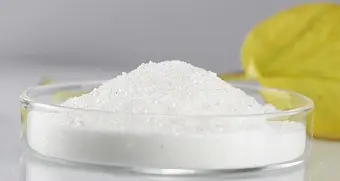Sodium Chlorate Market: Expanding Role in the Industrial World, Challenges & Future Horizons
02 Oct 2023 • by Natalie Aster

Sodium chlorate (NaClO₃) is a white crystalline substance that has found its place in a myriad of applications ranging from the paper industry to herbicides. Over the past few years, the global sodium chlorate market has experienced substantial growth. The market dynamics have been influenced by various factors including technological advancements, governmental regulations, and end-user demand shifts.
Historical Background
Sodium chlorate was first synthesized in the 19th century. However, its commercial significance took off in the 20th century, primarily driven by the pulp and paper industry. Over the decades, as technologies have evolved and new applications have emerged, sodium chlorate has established itself as an indispensable chemical in various sectors.
Major Applications of Sodium Chlorate
Pulp & Paper Industry
This remains the predominant consumer of sodium chlorate. It's primarily used for the bleaching of wood pulp which eventually goes into making white paper. The chemical aids in the oxidation of lignin, an organic polymer that's removed to whiten the pulp. As global paper consumption rises due to increasing population, urbanization, and education, the demand for sodium chlorate in bleaching processes has surged. Besides, in the push towards environmentally friendly processes, the industry is shifting from elemental chlorine bleaching to elemental chlorine-free (ECF) bleaching, where sodium chlorate plays a pivotal role.
Herbicides
Sodium chlorate serves as a non-selective herbicide. Its ability to control a wide range of weeds has made it a preferred choice in both agricultural and non-agricultural sectors, contributing to the rise in demand. When spread on unwanted vegetation, it prevents plant photosynthesis, leading to the plant's death. However, due to its broad-spectrum activity, care must be taken to ensure it doesn't affect desirable plants. In addition, with the global expansion of infrastructure, sodium chlorate is used to clear land by eliminating unwanted vegetation, further spurring its demand.
Others
Besides, sodium chlorate has found its way to a range of niche sectors such as the mining sector, where it's used as a pyrotechnic agent, and the chemical industry, where it functions as an oxidizing agent. Sodium chlorate can be used in water treatment processes, in particular, it can be broken down to produce chlorine dioxide, a disinfectant used to treat drinking water and in certain wastewater treatment applications. Sodium chlorate is employed in chemical oxygen generators, commonly found in commercial aircraft; when ignited, sodium chlorate decomposes to release oxygen, which can be vital in situations where cabin pressure is compromised. The mounting demand from diverse applications also bolsters the overall sodium chlorate market growth.
Insights into Regional Sodium Chlorate Markets
North America is the largest regional consumer of sodium chlorate. In this region, the sodium chlorate market is primarily driven by the pulp and paper industry. With major producers located in the United States and Canada, the regional market has seen a steady demand. Factors such as the rise in sustainable paper products and eco-friendly manufacturing processes have bolstered the demand for sodium chlorate.
Europe, with its diversified industries, has always been a significant consumer of sodium chlorate. Apart from the paper and pulp sector, the chemical and pharmaceutical industries contribute to the demand here.
Asia-Pacific is the rising giant in the sodium chlorate market landscape. The region, particularly China and India, has seen a robust demand for sodium chlorate. The increase in paper consumption, urbanization, and a surge in chemical industries are the pivotal growth driving factors.
Latin America, with countries like Brazil and Argentina, is gradually making its mark in the sodium chlorate world. The need for clean water and sustainable agriculture are the main drivers.
The Middle East & Africa, although smaller in comparison to other regional markets, has shown a growing interest in sodium chlorate, mainly for water treatment and herbicide production.
Key Challenges Facing the Sodium Chlorate Market
While the sodium chlorate market seems prosperous, it faces several challenges:
Environmental Concerns
As environmental sustainability becomes a focal point globally, industries face mounting pressure to adapt their practices to be more environmentally friendly. The production and usage of sodium chlorate can have environmental implications, especially concerning water pollution. The extensive use of sodium chlorate as an herbicide has raised environmental concerns, its residue can infiltrate water systems, potentially harming aquatic life.
Stringent Regulations & Compliance
While sodium chlorate has various applications, it also comes with certain hazards. With rising environmental and safety concerns, many regions have enforced strict regulations on the production, use, and disposal of sodium chlorate. Moreover, the reactive nature of sodium chlorate demands careful handling and storage.
Volatile Raw Material Costs
The production of sodium chlorate is dependent on various raw materials, the prices of which can be volatile. Fluctuating costs can make it challenging for producers to forecast expenses, potentially leading to reduced profitability and increased end-product prices.
Alternative Technologies & Substitutes
The advent of new technologies and research has introduced alternative substances that can replace sodium chlorate, especially in its primary application – the pulp bleaching process. These alternatives, if cost-effective and efficient, could reduce the demand for sodium chlorate in the future.
Market Saturation in Developed Regions
In many developed regions, the sodium chlorate market is reaching saturation, with limited growth opportunities. Manufacturers are compelled to explore emerging markets or diversify their product range to sustain growth.
Future Trends & Opportunities
With technological advancements, eco-friendly production methods, and a shift towards sustainable products, the future of the sodium chlorate industry seems promising. It is essential for companies to focus on research and development and explore new application areas to ensure steady market growth.
Sustainable Production
With increasing environmental consciousness, there's a surge in demand for eco-friendly production methods. Green technologies that reduce the environmental footprint of sodium chlorate production can offer a competitive edge.
New Applications
Research into novel uses of sodium chlorate can open up new market avenues. For instance, its potential use in energy storage or advanced oxidation processes can be areas of future exploration.
Untapped Potential in Emerging Markets
While established markets like North America and Europe have stable demands, regions like Africa and certain parts of Asia present untapped opportunities. Establishing a presence in these regions can be fruitful for sodium chlorate producers.
Bottom Line
The sodium chlorate market, while mature in certain regions, still presents ample opportunities for growth and innovation. By balancing environmental concerns with industrial demand, and by exploring new application areas, stakeholders can ensure a sustainable and profitable future in this market.
Product Details:
Sodium Chlorate: 2023 World Market Outlook and Forecast up to 2032
Published: October 2023
Pages: 150
Market Publishers boasts a rich collection of insightful research studies covering the chemicals and petrochemicals market, find it in the Chemicals & Petrochemicals Market Reports Catalogue.
CONTACTS
The Market Publishers, Ltd.
Natalie Aster
Tel: +357 96 030922
Fax: +44 207 900 3970
[email protected]
MarketPublishers.com
Analytics & News
